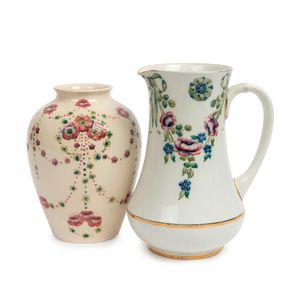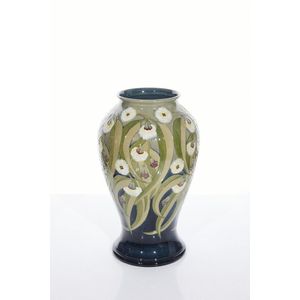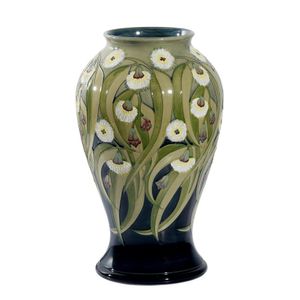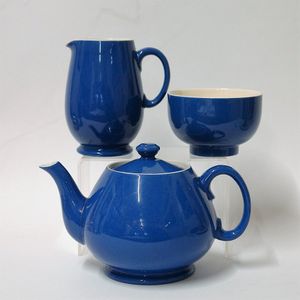
Moorcroft 'Pomegranate' Jardiniere for Liberty & Co, circa 1912
A Moorcroft jardiniere in 'Pomegranate' pattern, circa 1912, made for Liberty & Co, with tubelined fruits in colours on a mottled blue green ground, Liberty backstamp and facsimile signature underside, 17.5 cm high, 18 cm diameter

Florian Ware Jug and Bara Vase
A MacIntyre Florian ware jug and a Moorcroft for Liberty 'Bara' vase, circa 1900-1913, the carinate shaped jug with delicate festoons of flora upon a white ground, mark of Macintyre Burslem underside, and cream ground baluster vase with maroon pendents…

Limited Edition Moorcroft Liberty Vase 'Hawthorne' Pattern
A limited edition Moorcroft for Liberty 'Hawthorne' pattern vase, designed by Nicola Slaney c1990s, the Liberty exclusive vase, tube-line decorated in the 'Hawthorne' pattern, dated 98 and numbered 350/400, with impressed Moorcroft stamp and other cyphers…

Large Moorcroft Vase for Liberty & Co
A William Moorcroft (1872-1945) for Liberty & Co. 'Hazeldene', the rare large vase, circa 1910, decorated with blue/green tress in an extensive landscape. Painted signature in green, printed made for liberty & co.

Moorcroft Tasmanian Blue Gum Baluster Vase
Sally Tuffin for Moorcroft, large baluster vase, 1993, Tasmanian blue gum pattern, numbered 19/50, decorated with flowering gum nuts amongst gum leaves on a blue and green ground, signed and dated, height 42 cm. Provenance: Liberty Lane, Sydney, 1994.…

Moorcroft Two-Handled Form with Detachable Lid for Liberty & Co
Square two handled form with detachable lid, signed W Moorcroft in green and printed made for Liberty & Co. To the base, (small chip to one corner of lid and box rim edge) 17 cm height

Moorcroft Tasmanian Blue Gum Vase by Sally Tuffin
A large Moorcroft Tasmanian blue gum vase designed by Sally Tuffin; numbered 19/50, of baluster form decorated with flowering gum nuts amongst gum leaves on a blue ground, signed and dated: S. T. Des 4.10.93, signed and dated: J. Moorcroft 22.9.94,…

Moorcroft Tudric Lancastrian Poppy Pedestal Bowl for Liberty's
Moorcroft Tudric Lancastrian 'Big Poppy' pattern pedestal bowl made for Liberty's, the embossed pewter base stamped Tudric Lancastrian 01343, 25 cm dia. (repaired full length crack to the bowl)

Rare Moorcroft Hazeldene Vase for Liberty & Co
Rare William Moorcroft for Liberty & Co Hazeldene pattern vase, two handled tapering form, signature in green and Reg no 387964, c1903, 25 cm high

Moorcroft Flamminian Arts and Crafts Pottery Bowl
Moorcroft Flamminian English Arts and Crafts pottery bowl made for Liberty & Co. London, circa 1905, incised signature W. Moorcroft, Made For Liberty & Co. 6.5 cm high, 16 cm diameter

Moorcroft for Liberty 'Eventide' Comport with Tudric Stand
A William Moorcroft for Liberty 'Eventide' comport circa 1925, the shallow bowl richly decorated with a tree design on a graduated orange and red ground. Raised on a 'Tudric' pewter stand. Impressed factory mark to underside of plate. 'H/ made in England…

Moorcroft Liberty Tudor Rose Vase
Moorcroft Pottery Liberty vase, Tudor Rose, designed by William Moorcroft, c1904, for Liberty & Co. 17 cm high. Signed William Moorcroft

Moorcroft Vase & Dishes for Liberty, c. 1920
A William Moorcroft vase for Liberty of London & two dishes in powder blue vase, c 1920, impressed marks to base & back stamp [3], height 23 cm, Dia

Green Hazeldene Squat Vase by William Moorcroft for Liberty & Co
A William Moorcroft squat round vase, green hazeldene pattern, for Liberty & Co., Rd N 397964, W. Moorcroft, circa 1905, height 8 cm, diameter 11 cm

Sally Tuffin for Moorcroft Liberty Peacock Feather Vase
Sally Tuffin for Moorcroft, vase, c. 1988, Made for Liberty, 'Peacock Feather' pattern, decorated with tubelined feathers against a green ground, signed 'Liberty' with painted monogram of William J. Moorcroft, impressed 'Moorcroft, Made in England, height…

William Moorcroft 'Powder Blue' Tea Set from Liberty's
A William Moorcroft 'Powder Blue' three-piece tea set, comprising teapot, sugar and cream, impressed marks. As retailed and used in the Liberty's of London tea rooms.

Moorcroft 'Powder Blue' Liberty Coffee Set, 1920s
Moorcroft 'Powder Blue' coffee set consisting of 6 trios, coffee pot and sugar bowl, designed for Liberty of London tearooms, c.1920's

Moorcroft & Liberty Pewter Ashtray, Signed (c.1910)
Rare William Moorcroft and Liberty Tudric pewter cigar ashtray c.1910, signed

Moorcroft Silver Overlaid Claremont Exhibition Ewer
A rare William Moorcroft silver overlaid Claremont Exhibition ewer, for Shreve & Co, San Francisco, circa 1905 tapering in form, green and midnight blue ground with a repeating toadstool design, the handle, base and upper body are applied with silver…

Moorcroft Liberty Rouge Flambe Vase, 17 cm
Moorcroft for Liberty rouge flambe vase, marked LBI to base. Height 17 cm

Moorcroft Jardiniere in Claremont Toadstool Pattern
Large Moorcroft baluster jardiniere Claremont Toadstool pattern, made for Liberty & Co

Moorcroft Flamminain Vase & Pot for Liberty & Co
Moorcroft Flamminain vase & pot baluster vase, 13 cm high, ovoid pot (lacking lid) 8.5 cm high, made for Liberty & Co

Moorcroft Grape Ovoid Vase for Liberty - 10cm
Moorcroft ovoid vase grape pattern made for Liberty, 10 cm high

Moorcroft Flamminian Ware Vase, Liberty & Co
Moorcroft Liberty & Co. 'Flamminian Ware' vase decorated with foliate roundels against a green ground, incised signature, printed Rd no. 452777. Height 22 cm

Moorcroft Hazeldene Vase for Liberty & Co
William Moorcroft, small Hazeldene vase, C.1903, signed, stamped 'Made for Liberty & Co. Rd no. 397964', height 10 cm, diameter 8 cm, weight 200g

Moorcroft Liberty Vase, 1908
William Moorcroft, Vase, c. 1908, 18th century' pattern, decorated with swags of flowers against a cream ground, signed in green 'W. Moorcroft', printed 'made for Liberty & Co., height 27.5 cm. Provenance: Private Collection NSW

Moorcroft Landscape Vase for Liberty & Co
William Moorcroft for Liberty & Co., Vase, c. 1910, Hazledene' pattern, decorated with trees in a landscape in tones of green and blue, signed in green 'W. Moorcroft des', printed 'Made for Liberty & Co.', with printed registered design number '397964',…

William Moorcroft Flamminian Ware Vase for Liberty & Co
A William Moorcroft Pottery, Flamminian Ware vase, for Liberty & Co, circa 1910 with signature to base and printed factory mark. Height 20.8 cm

Moorcroft Pomegranate Vase for Liberty & Co
William Moorcroft for Liberty & Co., Twin-handled vase, c. 1911, 'Pomegranate' pattern, decorated with pomegranates, grapes and leaves on a mottled green ground, signed in green 'W. Moorcroft' and dated '1911, 'printed 'Made for Liberty & Co., height 19.5…

Moorcroft for Liberty Toadstool Vase
William Moorcroft for Liberty & Co., vase, c. 1912, 'Claremont' pattern, decorated with toadstools against a mottled green ground, signed in green 'W. Moorcroft', printed in green 'Made for Liberty & Co.', with registered design number '420081', restored…

Moorcroft Liberty Vase 'Hazledene' Pattern
William Moorcroft for Liberty & Co., vase, c. 1910, 'Hazledene' pattern, decorated with trees in a landscape in tones of green and blue, signed in green 'W. Moorcroft des', printed 'Made for Liberty & Co.', with printed registered design number '397964',…

Florian Ware Poppy Vase by William Moorcroft
William Moorcroft for Liberty & Co., Florian Ware vase, c. 1908, 'Poppy' pattern, decorated with poppies and leaves in tones of blue and green, signed in green 'W. Moorcroft des.', printed 'Made for Liberty & Co.', with registered design number '326471',…

William Moorcroft Flamminian Green Bowl for Liberty & Co
A William Moorcroft 'Flamminian' green bowl, circa 1930, for Liberty & Co. Diameter 20 cm. Signed and numbered 452777 to base

Restored Moorcroft Claremont Toadstool Vase with Liberty Mark
A William Moorcroft Claremont Toadstool squat vase (AF) - restored c.1903 - 1913. Painted green signature with 'Made For Liberty' mark. Height 7.5 cm. Diameter 19 cm

McIntyre Moorcroft Flamminian Vase for Liberty & Co
A McIntyre Moorcroft Flamminian vase, inverted baluster form, in a deep pea green with three tubelined medallions to the top decorated with Nouveau motifs in blue and cream, signature to base with registration number and 'Made for Liberty & Co.',…

Limited Edition Moorcroft Liberty Centenary Vase by Emma Bossons
A Moorcroft Pottery Liberty Centenary collection vase dated 2002, designed by Emma Bossons. Limited edition 88/100, signed Emma Bossons with factory marks. Height 28 cm

Moorcroft Flamminian Ware Lei Form Vase
A 'Flamminian Ware' vase, William Moorcroft for Liberty & Co., circa 1914, a large red glazed 'Lei form' vase, decorated with three stylized foliate roundels, incised 'W. Moorcroft' to base, 40 cm high

Moorcroft Flamminian Ware Vase, 1920
William Moorcroft Liberty Flamminian Ware vase circa 1920. Height 14 cm

Limited Edition 'Spirit of Liberty' Vase by Emma Bossoms
Moorcroft limited edition 'Spirit of Liberty' vase. By Emma Bossoms, #108/200, 2001. Height 37 cm

Green Swirling Moorcroft Inkwell for Liberty & Co
Moorcroft. English pottery inkwell made for Liberty & Co. Square form, green glaze with Arts and Crafts swirling motif on each side. Early 20th century. Some crazing, lid missing. 5 x 7 cm

 Loading more...
Loading more...